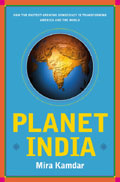As goes India, so goes the world. This phrase is a chorus, one that Mira Kamdar often returns to in her new book, Planet India: How the Fastest Growing Democracy Is Transforming America and the World. In the decades now rushing towards us, she claims, either India will find or develop solutions to a series of crushing problems and open the door to a more secure, sustainable, equitable — and likely Asian-led-future — or, globally, we don’t have much of a future to which we can look forward.
Kamdar is an associate fellow of the Asia Society and a former senior fellow at the World Policy Institute. In 2001, she wrote a widely read memoir, Motiba’s Tattoos: A Granddaughter’s Journey from America into Her Indian Family’s Past. In Planet India, she paints India not as a microcosm of the challenges that will define the global future but as a macrocosm. India, in her view, is the world writ large: politically, economically and culturally. The quintessential Indian questions — how to keep the peace both in and on the borders of a sprawling, multiethnic, democratic state, and how to equitably divide resources and elevate vast numbers of people out of poverty without devastating ecological degradation — are the defining questions of the 21st century.
A Different Kind of Capitalism?
India’s strengths are well known: A vast and growing, well educated, English-speaking middle class; a significant cost advantage over Europe and the United States in high-value industries; and internal pressures which make addressing issues of ecology and equity more matters of survival than choice. “My whole life,” Kamdar writes regarding the last issue, “I have heard members of India’s urban, educated elite observe, rather smugly, ‘Look at the conditions people live in. Anywhere else in the world there’d be a revolution, but not in India.’ Recently, I’ve heard people say that unless the lot of the poor improves soon and dramatically, the poor will rise up and slit the throats of the rich. ‘They have television now, you know. They can see the life they are denied.'”
Throughout the book, emphasis is laid on the manner in which a more efficient and humanely focused capitalism can forge solutions and address inequalities. For example, in an interview with Kamdar, Kiran Mazumdar Shaw, founder of the biotech company Biocon, argues that, “When corporate social responsibility is taken seriously, is focused on a critical challenge for India, uses the latest technologies and best practices, and works as a partner with the government, costs are driven down while the quality of service goes up. This is the only way India will deliver solutions on the scale and at the speed required to address its many problems.” (Editor’s note: India Knowledge at Wharton featured a podcast with Mazumdar Shaw in January 2007.)
Whether one sees the market as the problem or the solution, this is familiar rhetoric. It recounts the benefit, or the imperative, of “doing well by doing good,” elevating the poor as much for reasons of market expansion as moral necessity. But as much as or more than any of those incentives or advantages, Kamdar and the people she interviews — leaders in business and government, artists and academics, the occasional cab driver — stress a kind of Indian exceptionalism, the argument that India has a more solid cultural platform on which to build a more just and sustainable market economy. “India is a complicated, fractious, often cacophonous democracy,” she writes, “where viewpoints and visions clash and compete. Yet, I have found an astounding consensus around the notions of inclusion and sustainability, grounded in India’s unique cultural heritage.”
How These Changes Feel
While the bulk of the book focuses on concrete matters, statistics and quantifiable data, Kamdar regularly returns to the question of how the changes afoot in India make people feel, both at home and abroad — about the psychological impact of the tectonic shift she sees. In foreign quarters, reactions to India’s rise range from positive to negative anticipation or, off that scale, to indifference usually born of ignorance. Some see opportunity, some see threat, some see not at all.
Some Americans or Europeans express this threat in frankly racist terms. In her introduction, for example, Kamdar cites Guy Dollé, chief executive of the steel conglomerate Arcelor, speaking disdainfully on the occasion of the company’s takeover by Indian-owned Mittal Steel. He described Mittal as “a company full of Indians,” paying in “monkey money.”
For many or most Westerners, however, the issue is more one of economic competition, tinged with nationalism. This is nothing new or unique: In the 1980s, Americans were anxious about being economically overshadowed by Japan; in the 1990s, the Japanese began to worry about being eclipsed by the smaller “Asian Tigers,” like Korea; today, countries like Korea fret about being economically dwarfed by China. And the wheel goes ’round and ’round.
On the Indian side, while the emotional amalgam is complex, the dominant note, not surprisingly, is pride. This pride has deep roots in centuries of Indian history; it has, as well, a dash of schadenfreude born of the more recent colonial experience, a sense of satisfaction that power relations may soon be reversed, that Westerners long used to giving instructions and dictating terms may have to learn how to accept them instead.
Some anxiety exists on the Indian side as well. The Raj was a difficult period; the post-Independence era has been one of hopes raised and often dashed. In some ways, this anxiety is fuel for change. It provides and is emblematic of a sense of urgency. Kamdar quotes an unnamed Indian executive as saying, “We have a window of between five and seven years.”
“India does not have the luxury of time,” Kamdar writes. “It must immediately address a host of problems in ways that are scalable and sustainable. It must leverage new technologies to minimize environmental damage while maximizing scarce resources to bring badly needed benefits to a huge population.”
The Devil in the Details
Kamdar’s larger point is difficult to quarrel with: The numbers are compelling. India has a lot of demographic weight to throw around and the implications of that fact are clear in the country’s nascent, and growing, economic and cultural influence. In the smaller details, however, the book bogs down in a variety of areas. Kamdar has a tendency, for example, to lapse into somewhat breathless hyperbole, which at least slightly overstates certain points and can, at times, become repetitive. We don’t really need more than one reference to the CNN medical correspondent Sanjay Gupta, “the media-icon version of the trusted American family physician from India.” It is useful to learn that the American children’s television program Sesame Street now has an Indian version, in part for the ways in which this illuminates growing media cross-pollination and a relatively recent opening up to foreign influences. Less useful is an exhaustive list of other countries to which versions of the program have also been exported.
Kamdar is certainly right to point out the growing prominence of Indian influences in the U.S., from satellite television channels to cuisine. But as for her statement that “Frozen packs of pre-made Indian food are available in supermarkets everywhere [emphasis added]” — not quite yet.
At times, Kamdar seems to make contradictory points almost simultaneously. In analyzing the rise of television in India, for example, she writes: “Television’s ascendance in India has also coincided with a fragmentation of Indian politics, an increase in caste-based and regional-based parties and leaders, a series of national coalition governments — some more fragile than others — and the rise of Hindu nationalism.” On the following page, she writes, “Despite jarring economic inequities, television has provided a diverse population with a sense of national community during a period of intense economic, political, and social transformation.”
So is television helping to unify India or to incite further communal conflict? It could be doing both; and, in the first instance, she cites coincidence rather than clear causality. Still, one is left more puzzled than edified.
Much to Do; Not Much Time
These smaller issues take a back seat to the larger question at the heart of the book. Bluntly: Can India succeed?
While most of the people Kamdar interviews are ebullient about India’s future, she adds some critical voices as well. For example, in chapter five, “The Cities,” she looks at the progress being made by “green building” entrepreneurs, public/private partnerships and high-tech office parks, balancing this in part with the less sanguine observations of Naresh Fernandes, editor-in-chief of TimeOut Mumbai. “I’m not optimistic about the future of [Mumbai] at all, even though I love it dearly,” Fernandes tells her, detailing missed opportunities for reform and sustainable development. He later adds, “The people who have these delusions about the city’s future as another Shanghai are deranged.”
Ultimately, Planet India presents a vast and daunting balance sheet of global assets and liabilities, and pins the reader in a tenuous position. We are at a fork in the road, Kamdar suggests: Indian solutions or global failure. As goes India, so goes the world.
We root for India — some as a matter of national pride, some as a matter of global survival. What other option is there? But the picture Kamdar paints evokes as much foreboding as euphoria. The window in which India must succeed is closing fast.



